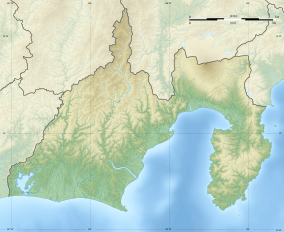Shinpōinyama Kofun group
Shinpōinyama Kofun group (新豊院山古墳群, Shinpōinyama kofun-gun) is cluster of kofun burial mounds dating from the late Yayoi to the early Kofun period located in what is now part of the city of Iwata, Shizuoka in the Tōkai region of Japan. The site was designated a National Historic Site of Japan in 1987.[1]
新豊院山古墳群 | |
 Shinpōinyama Kofun  Shinpōinyama Kofun group (Japan) | |
| Location | Iwata, Shizuoka, Japan |
|---|---|
| Region | Tōkai region |
| Coordinates | 34°46′16″N 137°52′26″E |
| Type | kofun |
| History | |
| Founded | 4th century AD |
| Periods | Kofun |
| Site notes | |
| Ownership | National Historic Site |
| Public access | Yes |
Overview
The Shinpōinyama kofun group is located on a low hill at the confluence of the Tenryū River with the Ota River. The necropolis consists of over 30 tombs in various styles, which were arbitrarily divided into four groups, Group A through Group D, by archaeologists. Due to construction work, Group D was excavated in 1980. It was found to contain two keyhole-shaped tumuli and one square tumulus from the Kofun period and three graves from the earlier Yayoi period, along with a large amount of Yayoi period pottery shards. The two keyhole-shaped tumuli has lengths of 33 meters and 34 meters respectively.
The 34-meter tomb was excavated, and found to contain a stone-lined burial chamber in which gravel and clay are alternately stacked in holes of 8.1m from east to west and 5.6m from north to south. It contained stone sarcophagus with a wooden coffin. It was built in the first half of the 4th century, based on excavated earthenware, making it one of the oldest in the prefecture. Inside were numerous grave goods, including a bronze hammer, iron swords, and Chinese-made bronze mirror with a triangular rim and design of mythical animals, along with pottery from the early Kofun period.
The third tomb, a 12-meter trapezoidal-shaped tomb, and with the burial part in gravel, contained a sword and spear, and an iron casket, Earthenware (Haji ware) pottery from the second half of the third century was excavated.
The site is on a hill behind a Buddhist temple, with limited public access.
References
- "新豊院山古墳群" (in Japanese). Agency for Cultural Affairs.
External links
- Iwata city tourist information home page (in Japanese)